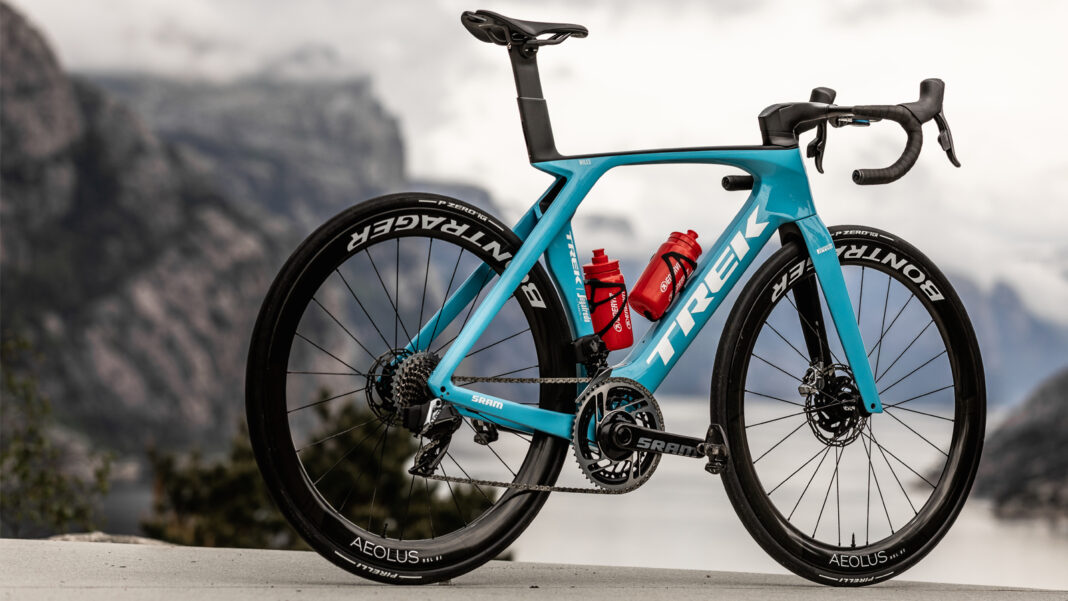Let’s be honest, the release of the new Trek Madone is no great shock to anyone; the radical-looking seattube first spotted at the Dauphine is pretty hard to hide from even the most inattentive fans. But today’s the day it becomes official from Trek, so here we have it, the new Trek Madone SLR. The 7th generation all-out aero bike from the Wisconsin megabrand.
There are some big changes to cover compared to the old Madone, which naturally featured in our list of the best aero bikes , but this remains a road bike focussed on cheating the wind in every way it can. The headlines are, as per the new bikes officially released pre-Tour from Scott and Pinarello , that the new Madone SLR is faster and lighter than ever before. How much lighter? How much faster? Let’s dig into the details and find out.
(Image credit: Trek) That seattube Let’s attack the yawning chasm beneath the rider before we do anything else. Trek has ditched the isospeed system, whereby a tuneable pivot allowed the seatpost to flex in favour of what is now dubbed isoflow. The isoflow frame design not only saves a great deal of weight from the frameset, it allows for smoother airflow around the rear of the bike, improving the aerodynamic profile.
Comfort hasn’t been done away with, as the now cantilevered, flying seatpost provides much needed flex that cannot realistically be achieved by the small seatpost extensions that come with horizontal- and near-horizontal top tubes. What’s more, in a telling admission from Trek, most Madone riders never adjusted their isospeed setup anyway, meaning the tunable nature of the compliance wasn’t really necessary, empowering it to simplify the system. Faster and lighter The new Madone SLR is a claimed 60 seconds per hour faster and 300g lighter than the outgoing model.
The wattage savings, 20 of them at a relatively nippy 45km/h, are half attributed to improvements in frame aerodynamics, and half down to ‘improved rider positioning’. A 20-watt improvement for any new bike is a big leap, so this is going to take a bit of deconstructing. 10 watts for a new frame isn’t outlandish by any stretch, and Trek has achieved this not only through the bold new seat tube, but by smaller aero gains elsewhere.
The new one-piece bar-stem has been redesigned with a new spacer stack too to reduce the frontal area. The other major overhaul comes at the bottom bracket area, where the BB shell extends above the upper limit of the large chainring to meet the bottom of the bottle cages, reducing turbulent flow in the void between the two, and improving stiffness as a by-product. These wind-cheating improvements were modelled using ‘unstable aerodynamics’, which presumably means things were a bit gusty in the wind tunnel, and using a repeatable mannequin rather than an actual human rider.
A removable front derailleur hanger and cover round out the overhaul, smoothing out the airflow even more on flatter days where an inner ring is surplus to requirement. That 300g weight saving is a combination of the frame and cockpit, and results in a total bike weight of a 56cm Madone SLR 9 eTap (SRAM Red eTap AXS) of 7. 4kg.
(Image credit: Trek) Flared bars aren’t just for gravel Since the UCI decided to ban the ‘puppy paws’ position, which saw riders with their forearms on the top tube to gain an aero advantage, we’ve seen many resorting to turning their hoods inwards to reduce their frontal area whilst still remaining within the boundaries of the UCI’s labyrinthine rulebook. Trek has decided to factor this tactic into the new Madone SLR, resulting in a bar that has a 3cm flare at the drops compared to the tops. It is this flare, and the reduced frontal area that results from it, that is the cause of the other 10 watt saving from ‘improved rider position’.
It’s worth noting here that Trek is measuring bar width at the drops, rather than the hoods as is more common. As such, it is comparing the aerodynamics of a 42cm bar (with hoods at 39cm apart) against a 42cm bar with zero degrees of flare. That being said, Trek envisages the drops will be used for general riding, sprinting, and descending, while the tops will be a place to narrow your shoulders, tuck your head in, and try and punch a hole through the atmosphere.
While flared bars are more the preserve of the gravel rider, the tyre clearance of the new Madone is still that of a road bike; it comes with 25mm as stock, but can fit 28mm officially, and probably 30mm unofficially. Spec and availability The new Trek Madone SLR will be available in five colourways. A superlight option of raw carbon and a holographic logo, two team colourways to match the men’s and women’s Trek-Segafredo bikes, an eye-catching metallic red fading to raw carbon, and a much more subdued all white number which eschews the giant TREK logo on the downtube in favour of diminutive wordmarks on the toptube.
These five colours will be available in six specifications, though they will all be electronic only and disc brake only. Until recently this would mean you’re confined to the upper echelons of the groupset world, but the lowest spec model features the new Di2 105 groupset from Shimano. Pricing will range from $13,199.
99 / €14,999 / £13,800 for the SRAM Red eTap down to $7,999. 99 / €7,699 / £6,850 for the 105 Di2 spec, or if you just want a frameset to built up how you wish it’ll set you back $4,599. 99 / €5,499 / £5,000.
.
From: cyclingnews
URL: https://www.cyclingnews.com/news/new-trek-madone-2023/



